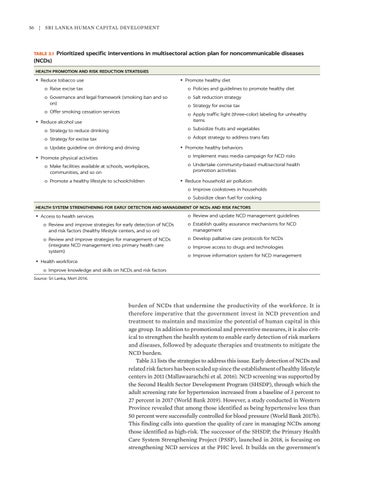56 | Sri Lanka Human Capital Development
TABLE 3.1 Prioritized
specific interventions in multisectoral action plan for noncommunicable diseases
(NCDs) HEALTH PROMOTION AND RISK REDUCTION STRATEGIES
• Reduce tobacco use
• Promote healthy diet
o Raise excise tax
o Policies and guidelines to promote healthy diet
o Governance and legal framework (smoking ban and so on)
o Salt reduction strategy
o Offer smoking cessation services
o Apply traffic light (three-color) labeling for unhealthy items
• Reduce alcohol use
o Strategy for excise tax
o Strategy to reduce drinking
o Subsidize fruits and vegetables
o Strategy for excise tax
o Adopt strategy to address trans fats
o Update guideline on drinking and driving
• Promote healthy behaviors o Implement mass media campaign for NCD risks
• Promote physical activities o Make facilities available at schools, workplaces, communities, and so on o Promote a healthy lifestyle to schoolchildren
o Undertake community-based multisectoral health promotion activities
• Reduce household air pollution o Improve cookstoves in households o Subsidize clean fuel for cooking
HEALTH SYSTEM STRENGTHENING FOR EARLY DETECTION AND MANAGEMENT OF NCDs AND RISK FACTORS
• Access to health services
o Review and update NCD management guidelines
o Review and improve strategies for early detection of NCDs and risk factors (healthy lifestyle centers, and so on)
o Establish quality assurance mechanisms for NCD management
o Review and improve strategies for management of NCDs (integrate NCD management into primary health care system)
o Improve access to drugs and technologies
• Health workforce
o Develop palliative care protocols for NCDs o Improve information system for NCD management
o Improve knowledge and skills on NCDs and risk factors Source: Sri Lanka, MoH 2016.
burden of NCDs that undermine the productivity of the workforce. It is therefore imperative that the government invest in NCD prevention and treatment to maintain and maximize the potential of human capital in this age group. In addition to promotional and preventive measures, it is also critical to strengthen the health system to enable early detection of risk markers and diseases, followed by adequate therapies and treatments to mitigate the NCD burden. Table 3.1 lists the strategies to address this issue. Early detection of NCDs and related risk factors has been scaled up since the establishment of healthy lifestyle centers in 2011 (Mallawaarachchi et al. 2016). NCD screening was supported by the Second Health Sector Development Program (SHSDP), through which the adult screening rate for hypertension increased from a baseline of 3 percent to 27 percent in 2017 (World Bank 2019). However, a study conducted in Western Province revealed that among those identified as being hypertensive less than 50 percent were successfully controlled for blood pressure (World Bank 2017b). This finding calls into question the quality of care in managing NCDs among those identified as high-risk. The successor of the SHSDP, the Primary Health Care System Strengthening Project (PSSP), launched in 2018, is focusing on strengthening NCD services at the PHC level. It builds on the government’s




